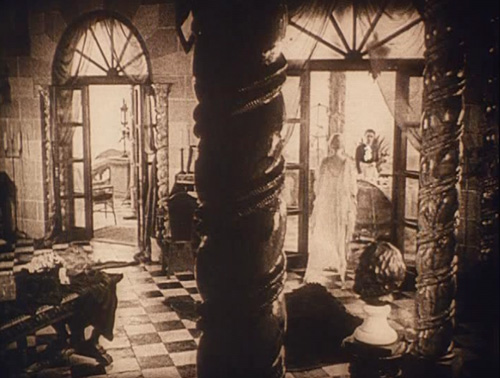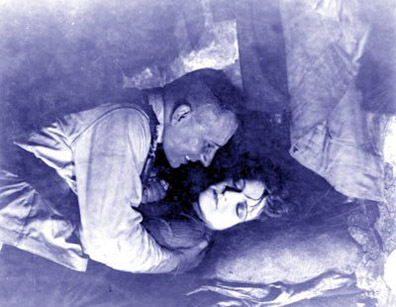From Monthly Film Bulletin, November 1976 (Vol. 43, No. 514). –- J.R.

Foolish Wives
U.S.A., 1922
Director: Erich von Stroheim
Cert—A. dist–BFI. p.c–Universal Super Jewel. p–Carl Laemrnle. asst. d–Edward Sowders, Jack R. Proctor, Louis Germonprez. special asst. to Stroheim–Gustav Machaty. sc–Erich von-Stroheim. ph–Ben Revnolds, William Daniels. illumination and lighting effects—Harry J. Brown. ed–Erich von Stroheim, (release version: Arthur D. Ripley). a.d—E. E. Sheeley, Richard Day. scenic artist—Van Alstein [Alstyn]. technical d–William Meyers, James Sullivan, George Williams. sculpture–Don Jarvis. master of properties–C. J. Rogers. m—[original score by Sigmund Romberg]. cost–Western Costuming Co., Richard Day, Erich von Stroheim. titles–Marian Ainslee, Erich von Stroheim. research asst-J . Lambert. l.p—Rudolph Christians/Robert Edenson (Andrew J. Hughes), Miss Du Pont [Patsy Hannen] (Helen Hughes), Maude George (“Princess”Olga Petschnikoff), Mae Busch (“Princess” Vera Petschnikoff), Erich von Stroheim (“Count” Sergei Karamzin), Dale Fuller (Maruschka), Al Edmundsen (Pavel Pavlich, the Butler), Cesare Gravina (Signor Gaston), Malvina Polo (Gaston’s Daughter [Marietta]), Louis K. Webb (Dr. Judd), Mrs. Kent (Mrs, Judd), C.J. Allen (Albert I, Prince of Monaco), Edward Reinach (Secretary of State of Monaco). 2,765 ft. (at 24 f.p.s.) 77 min. (16 mm.) Original 35mm footage–l4,l20 ft.
Monte Carlo, 1919. “Count” Wadislas Sergei Karamzin, living in a luxurious villa with “Princesses” Olga and Yera Petschnikoff, who pose as his cousins, receives a visit from Signor Gaston, a lower-class counterfeiter who supplies him with fake banknotes, accompanied by his retarded and attractive young daughter. After reading in the paper about the arrival of the wealthy Mr. Hughes and his wife Helen from America, Karamzin contrives to meet the latter on the terrace of her hotel while her husband is being received at the palace by Prince Albert, and a flirtation ensues. On a country outing during which Olga comes along as chaperone, Karamzin and Helen are caught in a storm; after he finds shelter for the night in a hut belonging to a crippled old woman, Karamzin sends one of Olga’s two dogs back to the inn with a note asking Olga not to leave until they’ve returned. Karamzin secretly watches Helen change into the crone’s dry rags with the aid of a pocket mirror, and then tries to seduce her, but is interrupted by the arrival of a monk. Returning to Monte Carlo the next day and leaving Helen at her hotel, Karamzin is reminded by his maid Maruschka of his proposal of marriage to her; faking tears with the aid of a finger bowl, he persuades her to give him all her savings. That night, at the casino, he helps Helen win an enormous sum of money and makes a date with Mr. Hughes for a poker party. Later, he entices Helen to his villa with a love note and tells her he must pay off a gambling debt of 95,000 francs by morning. She offers to give it to him; but Maruschka, watching the couple through a keyhole, becomes enraged and sets fire to the villa. After fire-engines arrive, Karamzin insists on jumping into the net ahead of Helen. Maruschka kills herself by leaping from a precipice into the sea. In his hotel with Helen, Hughes discovers Karamzin’s love note; he rushes to the casino and knocks him down. Later that night, Karamzin climbs a trellis into the bedroom of Gaston’s daughter. Leaving the villa, Olga and Vera are intercepted by the police, presented with their criminal records, and stripped of their wigs. Karamzin, now dead, is dragged outside by Gaston and deposited in a sewer.
“This print, although fragmentary, is the most complete in existence today”, reads the title introducing this edition of Stroheim’s masterpiece, reconstructed by Arthur Lennig at the American Film Institute by editing together footage from the Italian and American versions (which are substantially different in many respects — vide Jacques Rivette in Cahiers du Cinéma No. 79). Astonishingly, it is the only Stroheim film in distribution in this country, and like all his other surviving films (excepting only Blind Husbands, the first) it represents merely a fragment of his original work. “They are showing only the skeleton of my dead child”, he remarked after the film’s release in 1923; by then, the 21,000 feet of his own ‘final version’ — an 11,000-foot reduction of the film he first edited — was pared down by a third for the New York premiere (which reportedly ran for 210 minutes, with a 5-minute intermission), and then by another 4,000 feet for national release, before a group of censorship bodies proceeded to make further ravages. Considering all these reductions, it would perhaps be only a slight exaggeration to call the Foolish Wives that we have today just a few of the bones left in the skeleton, as magnificent as these relics might be. Like a palimpsest, this version bears traces of interference not only in its gaps but in what remains: ‘Signor Gaston’ is the name in the Italian version for a character originally known as ‘Cesare Ventucci’, and the wealthy Andrew J. Hughes — prophetically known as ‘Howard Hughes’ in the complete Italian version — who started life as a “special American envoy” and ambassador to Monaco, now appears in the film “on a commercial mission from America” which is never clarified. (As far as possible, the above credits and synopsis reflect the film’s present condition; one should add that Rudolph Christians — the actor playing Hughes — died in mid-production and was replaced by Robert Edenson, who apparently figured only fleetingly as a double in the remaining scenes.) Yet what survives is still so formidable on its own terms that it leaves no doubt about Stroheim’s brilliance as a director and actor; no other work offers as much evidence of his talent in both capacities. Half a century later, the multiple ambiguities concerning Stroheim’s own legend and public persona serve to enhance the plot of Foolish Wives on so many different levels that it remains as difficult now as it was then to isolate the film from its maker. During production, Universal put up an electric sign on Broadway reporting the film’s cost at weekly intervals, with the director’s name given as o’$troheim”. Coupling this with Karamzin’s extravagance as ‘actor’ and’ director’ (wheedling money out of Helen and Maruschka alike with fake tears, ‘staging’ any number of grandiose scenes to further his designs) and Stroheim’s own presence in the plot as author –- Helen is seen reading a book called “Foolish Wives by Erich von Stroheim” when Karamzin first meets her, and the same book reappeared in oracular fashion at the end of the original version to counsel Helen on the folly of her ways — one realizes that the film’s pleasure is predicated on the audience’s recognition of artifice and pretense throughout. Insofar as Karamzin’s monocle suggests a camera lens and his counterfeit money provides the fictional counterpart of Stioheim’s ‘precise reproduction’ of Monte Carlo in studio sets, the entire film can be read as an autobiographical account of how much an ‘imposter’ can get away with — and how much, indeed, we want him to get away with it. (“Here is a real trip to Monte Carlo”, reads one of the film’s original ads. “Go! Gamble, make love, talk French, be a devil of a fellow… $6000 worth of almost wicked thrills a minute”.) Teasingly ambiguous from the word go, the film introduces us to Karamzin doing target practice — firing towards the camera, as if to give us fair warning — before he settles down to a sumptuous breakfast of caviar on his villa terrace, which is lovingly enclosed within an iris. But the action is set only three months after the Armistice of November 11, 1918, and emblems of the War providing a bitter counterpoint to this opulence are never far away: Monte Carlo is teeming with veterans, and even at the country inn, a little boy in an oversized army helmet is seen picking his nose next to Karamzin’s café table. For the most part, Stroheim keeps such evidences of deprivation tucked into the margins of the plot, which makes their appearances all the more striking — particularly in the running motif of the supposedly rude veteran who fails to pick up Helen’s dropped book and purse at her hotel on separate occasions, and who subsequently proves to be armless, cruelly implicating the spectator’s own earlier assumptions along with the heroine’s. An equal measure of contrast is offered by the slum where the counterfeiter lives with his daughter and where Karamzin eventually perishes (although it is never made clear why the counterfeiter chooses to live in such impoverished circumstances). In the original version, Katamzin’s corpse was last seen “floating out to sea with other rubbish”, and his rape of the daughter (completed in Stroheim’s synopsis, but ‘attempted’ in most accounts of the original version) and subsequent death at the counterfeiter’s hands were apparently visible as well. But just as crucial an element in the plot’s dark underside is Karamzin’s passionate and homely maid Maruschka; perhaps the film’s most electrifying moment is the extended close-up of Dale Fuller behind a bed-rail after discovering Karamzin’s deception, where one can actually observe the revenge being hatched in her eyes. In a movie where the looks that charactersgive one another define the central terms of evaluation — Karamzin’s ‘inventory’ of the daughter is no less an ‘estimate’ than Helen’s sizing up of Karamzin — it should be noted that the extraordinary photography of Ben Reynolds and William Daniels captures the varied textures of Stroheim’s world in such vivid detail that the spectator’s eyes are given a comparable workout. Invited to explore the density and diversity of an obsessive imagination, one finds it difficult not to become as implicated in the ambiguity of its charms and postures as the director himself.
JONATHAN ROSENBAUM






